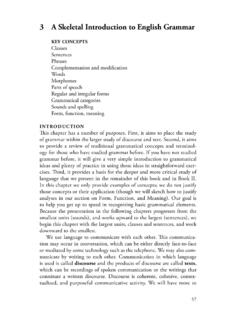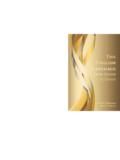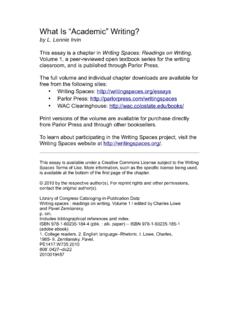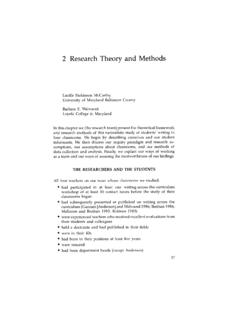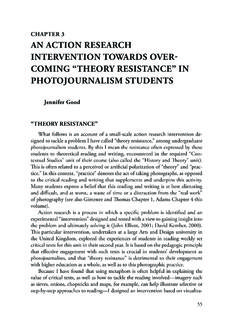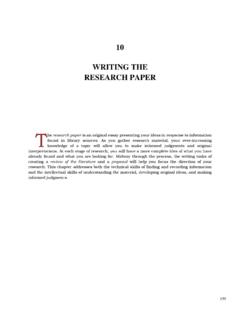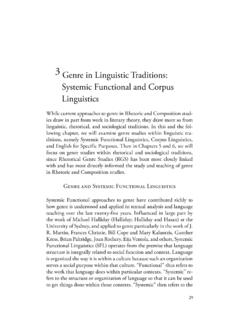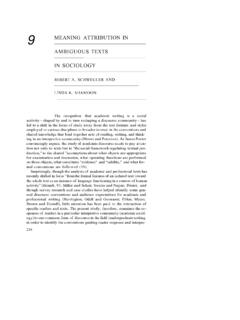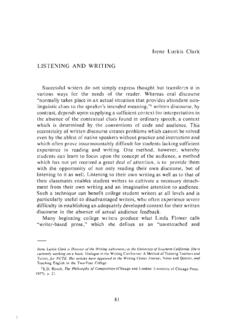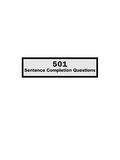Transcription of 1 Introduction to the Linguistic Study of Language
1 1 introduction to the linguistic study of Language key concepts Who these books are for How to use these books What these books are about Communication Language Discourse Text Genre Ideology Language in education Thinking critically about Language Standard english Grammar Other reasons for studying and teaching about Language The organization of these books Hints for success w h o t h e s e b o o k s a re f o r This is the first of two books for teachers about the english Language . We be- lieve that all teachers, not just english teachers, share the responsibility for helping students develop their abilities to speak, read, and write. Students must learn to communicate appropriately about math, chemistry, history, and every other school subject.
2 Teaching students these skills necessarily ex- tends across the curriculum. Thus, while one part of our intended audience is english K-12 teachers, we have prepared this book and its companion with teachers (and student teachers) from all disciplines in mind. h ow t o u s e t h e s e b o o k s In these books, we use certain typographical marks to help you focus on key points. Important terms are bolded. You can find their definitions in the text and in the glossary. Examples are noted in italics or are separated from the text. w h a t t h e s e b o o k s a re a b o u t These books are about Language , but specifically about the english Language 3. Delahunty and Garvey and its uses.
3 The first book is about the grammar of english ; the second is about related topics, including Language variation ( , dialects), Language learning, english spelling, and the history of the english Language . Generally, when people hear the word grammar, they immediately think of correct or incorrect and good or bad Language . Thinking about Language in this way is said to be prescriptive. english has a long tradition of judging some expressions as correct and others as incorrect.. For example, expressions such as We was are viewed as incorrect, even though a great many people use them. The correct version is said to be We were. Counter-posed to the prescriptive tradition is the descriptive one, which developed in linguistics, anthropology, and sociology.
4 This approach is concerned with describing and understanding the Linguistic behavior of a community, without judging it. From a descriptive point of view, We was is unobjectionable when used by a member of a community of speakers who characteristically use this expression. However, it is unacceptable to the wider english speaking community in, for example, formal speaking and writing. The point of view presented in these books is essentially descriptive. However, except where the topic is explicitly about Linguistic variation, we describe the form of english used in relatively formal public speaking and writing. We recognize that Language changes, and that consequently even the prescriptive rules have to change.
5 We believe that these rules should be descriptions of the best accepted practices of the day rather than imposi- tions (often irrelevant) on the Language and its use. communication Communication occurs when one person acts with the intention of influ- encing the mind of another, for example, by getting him/her to entertain some idea, and when that other person recognizes the first person's inten- tion to influence his/her mind. Clearly, it is possible to influence another person's mind unintentionally; for instance, if I (unintentionally) sneeze, I might prompt you to think that I might have a cold. However, this is a rather different kind of event than one in which I intentionally sneeze and you recognize that my sneeze was intentional.
6 From my first (unintentional). sneeze, you cannot infer that I am trying to get you to think I have a cold;. from my second (intentional) sneeze, you can infer that I am trying to get you to think something or another, perhaps that I have a cold. Imagine that we have gone to a party together and that we want to co- ordinate our leaving. So, before we get to the party I say to you, I'll pre- 4. Introduction to the Linguistic Study of Language tend to sneeze when I'm ready to go home, and you agree to interpret my sneeze in this way. When I sneeze at the party you can infer that I sneezed intentionally and interpret my sneeze as indicating my desire to leave. For this communication to succeed two elements must be in place: first, the assumption that I intend to influence you in some way, and sec- ond, our agreement about the meaning of my intentional sneeze.
7 There is nothing in the nature of a sneeze that requires it to mean Let's go home.. We could have agreed that it was to mean, It's safe to slip upstairs to steal the host's jewelry. By specifying a meaning for a sneeze, we have created a little code, a sort of miniscule Language . Language Fortunately, we cannot read each others' minds. So, if we want to allow some- one access to what we are thinking, we must provide them with clues that they can perceive. Language is a system that connects thoughts, which can not be heard, seen, or touched, with sounds, letters, manual signs, or tactile symbols ( , Braille) which can. In this way, one person's private ideas may be communicated to another person.
8 For example, imagine that I want to communicate to you my idea that my Study needs to be tidied up. You can't see, hear, touch, taste, or otherwise perceive that idea; it's locked away in my mind. To communicate it to you I have to cast it in a form that you can perceive typically in spoken, visual, or tactile form that is systematically connected to the idea, for example, the sentence, My Study needs to be tidied up. Without this perceivable expression, you cannot know that I have an idea to communicate; without the systematic connection between the idea and the form of the expression, you cannot know which idea I want to communicate. So, Language is a code that systematically connects private thoughts with pub- lic expressions.
9 These books are about the systems we use to connect private ideas to public activities. Language has been a major topic of research for well over two centuries. Linguistic research intersects with anthropology, biology, computer science, history, human development, literature, philosophy, politics, psychology, as well as reading and writing. discourse When we communicate we engage in discourse; that is, we deploy Language with the purpose of providing our audiences with clues about how we want to influence them. All discourse takes place in context; that is, the producer of a piece of discourse (speaker/writer) purposefully deploys, at some time and in some 5. Delahunty and Garvey place, clues about his or her intention which are to be interpreted by their intended recipient(s) (audience).
10 The clues have, generally, been selected with that audience, in that time and place, and with those purposes in mind. Some scholars argue that because different discourse situations require different patterns of communicative practice, we must speak of discours- es rather than of discourse (Gee 1992, 1996). We have, for instance, the discourse in which we are currently engaged the discourse of linguistics, which differs from the discourse of literary Study , which differs from the dis- course of chemical engineering, which differs from the discourse of history, and so on. A student who aims to be a practitioner in a field must master the ways in which practitioners in that field communicate with each other about topics in the field.
